Wildlife of the Tulare Basin
The Tulare Basin hosts an amazing concentration of endangered, threatened, or sensitive animal species, including nine invertebrates, three amphibians, five reptiles, 42 birds, and 13 mammals. Some animals are only found in the Tulare Basin, others are endemic to California and a few range throughout western North America.
Over the past century, modifications to the Tulare Basin's land and water have resulted in the critical status given to these animals. Loss, fragmentation, and degradation of wetlands and uplands have reduced the availability of food and other resources, while restricting and isolating populations. A variety of factors contributed to habitat loss and continues to threaten these species:
The Tulare Basin Wildlife Partners works to protect our unique and exciting animal diversity, resulting in a watershed that is more vibrant, resilient, and healthy for people and nature alike.
Over the past century, modifications to the Tulare Basin's land and water have resulted in the critical status given to these animals. Loss, fragmentation, and degradation of wetlands and uplands have reduced the availability of food and other resources, while restricting and isolating populations. A variety of factors contributed to habitat loss and continues to threaten these species:
- Changes in agricultural practices or poorly-managed grazing
- Changes in water flow and management
- Invasion of non-native plants
- Mining and petroleum extraction
- Off-highway vehicle use
- Parasites and disease
- Pesticide, insecticide or rodenticide spraying and drift
- Predation from introduced species
- Shooting, trapping and poisoning
- Urbanization and industrial developments
- Water pollution and degraded water quality
- Climate change
The Tulare Basin Wildlife Partners works to protect our unique and exciting animal diversity, resulting in a watershed that is more vibrant, resilient, and healthy for people and nature alike.
Listed below are descriptions for several of the Tulare Basin's sensitive animals:
Blunt-nosed Leopard Lizard (Gambelia sila); Federally & State Endangered
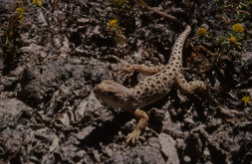
The blunt-nosed leopard lizard, a relatively large animal with a short, blunt snout and long, regenerative tail, features a multicolored striping pattern on its back, which breaks into spots as the lizard grows. Blunt-nosed leopard lizards feed primarily on insects, particularly grasshoppers, crickets, and moths, as well as small mammals and other lizards. These lizards inhabit expansive arid areas with scattered vegetation below 2,600 feet, such as California annual grassland and saltbush scrub. Blunt-nosed leopard lizards construct shallow, simple tunnels in earth berms or under rocks or use abandoned rodent burrows for shelter from predators and temperature extremes. Unique to California, blunt-nosed leopard lizards formerly ranged from the foothills surrounding the San Joaquin Valley throughout the valley floor, between Stanislaus and Kern counties. Today, the blunt-nosed leopard lizard is found only in isolated locations throughout this range, including a few in the Tulare Basin.
Giant Garter Snake (Thamnophis gigas); Federally & State Threatened
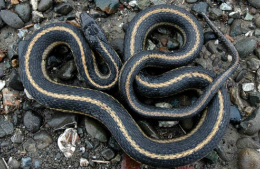
The largest garter snake, the giant garter snake grows to over five feet long. Its three distinctive yellow stripes stand out against its overall brownish color. Giant garter snakes feed primarily on carp, minnows, mosquitofish, Pacific tree frogs, and bullfrogs. Their ideal habitat contains dense cattails and bulrushes found in marshes and sloughs for escape from predators; ponds and small lakes in which to forage and seek cover; grassy banks and open areas along the water's edge to allow for basking; and upland habitat with access to burrows for hibernation and escape from flooding. Endemic to California's Central Valley, giant garter snakes historically ranged from Butte County to Kern County but now exists in only 13 separate populations, with none remaining in the Tulare Basin.
California Red-legged Frog (Rana aurora draytonii); Federally Threatened & California Species of Special Concern
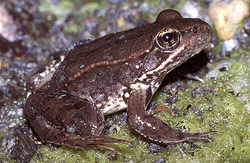
The largest native frog in the western United States, the California red-legged frog grows up to five inches long and features dark spots on its back with a red abdomen and hind legs. Frog larvae eat algae, while adults eat invertebrates and even Pacific tree frogs and mice. The California red-legged frog occupies a fairly distinct habitat, combining both aquatic and riparian components, such as dense, shrubby or emergent riparian vegetation closely associated with deep or slow-moving water. During intense summer heat, these frogs aestivate, or enter a dormant state, in small mammal burrows and moist leaf litter in well-vegetated terrestrial areas within the riparian corridor. Unique to California, this frog historically ranged from the coast to inland areas throughout much of the state. While still locally fairly common in some areas of the state, the California red-legged frog is no longer found in the Tulare Basin.
Swainson's Hawk (Buteo swainsoni); State Threatened
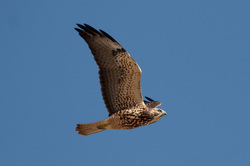
Swainson's hawk, a large bird distinguished by its long, narrow, pointed wings, displays a wide variation in plumage color and pattern. In the summer, these hawks eat insects, birds, and small mammals, occasionally taking reptiles, amphibians, and other invertebrates. During migration and in the winter, their diet consists mainly of insects. Swainson's hawks prefer open habitats, such as grasslands, with scattered trees for perching and nesting. Swainson's hawks also favor irrigated agricultural areas, particularly alfalfa fields, and exploit the abundance of prey made available when the fields are plowed. Swainson's hawks breed in western North America and winter in Argentina. Populations of this hawk have declined by 90% since the 1940s; only a few pairs of Swainson's hawks nest in the Tulare Basin.
Burrowing Owl (Athene Cunicularia); California Species of Special Concern

The burrowing owl is a small ground-dwelling owl with a round head, white eyebrows, yellow eyes, and long stilt-like legs. The owl is sandy colored on the head, back and upperparts of the wings and white-to-cream with barring on the breast and belly. An opportunistic feeder, burrowing owls eat beetles and grasshoppers, as well as small mammals, such as mice and gophers. They occasionally prey on reptiles, amphibians, scorpions, young cottontail rabbits, bats, and other birds. Commonly seen perching on fence posts or on top of mounds, burrowing owls inhabit open, dry grasslands and edges of agricultural fields. As their name suggests, burrowing owls nest in burrows in the ground, often in old ground squirrel burrows. These owls range throughout western North America, from Canada to Mexico and east to Louisiana, but in California, they are declining. The Tulare Basin features one of the largest populations of this species in the state.
Western Yellow-billed Cuckoo (Coccyzus americanus occidentalis); State Endangered
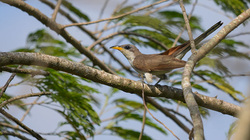
The western yellow-billed cuckoo, a medium-sized bird, has a slender, long-tailed profile, with a down-curved bill that is blue-black above and bright yellow below. Its plumage is grayish-brown above and white below, with rusty-colored flight feathers and white spots on the underside of the tail. They primarily eat caterpillars, katydids, tree frogs, and grasshoppers. The western yellow-billed cuckoo inhabits large contiguous areas of riparian woodlands dominated by cottonwoods and willows. Historically found throughout western North America, the western yellow-billed cuckoo was common throughout much of lowland California, including the wooded sloughs in the vicinity of Buena Vista Lake and along the Kern River channel. Today, the western yellow-billed cuckoo is no longer found in the Tulare Basin.
Tricolored Blackbird (Agelaius tricolor); California Species of Special Concern

Tricolored blackbirds closely resemble red-winged blackbirds, but have red and white shoulder patches. Tricolored blackbirds feed on grasshoppers and other insects, a variety of invertebrates and grain. This bird inhabits cattails or bulrushes in freshwater marshes, uplands, and agricultural fields with grain crops or alfalfa. Tricolored blackbirds breed in large colonies of up to 100,000 nests. More than 95% of tricolored blackbirds live in California, with the largest colonies historically located in the Central Valley. Since the 1930s its numbers have declined by more than 50%. In parts of the Tulare Basin, tricolored blackbirds depend on row crops, such as triticale for nesting and pasture land for foraging.
Buena Vista Lake Shrew (Sorex ornatus relictus); Federally Endangered
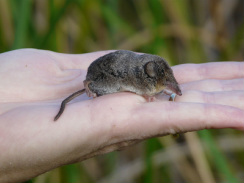
The Buena Vista Lake shrew, one of nine subspecies of the ornate shrew, features a long snout, tiny bead-like eyes, ears that are concealed by soft fur, and five toes on each foot. It is approximately the size of a small mouse. While the specific feeding habits of the Buena Vista Lake shrew are unknown, in general, shrews feed day and night on invertebrates to maintain their extremely high metabolic rate. This animal lives in dense vegetation made up of cottonwoods, willows, grasses, and rushes around the perimeter of marshes, lakes, or sloughs. Found only in the southern part of Tulare Basin, Buena Vista Lake shrews historically lived in the wetlands around Buena Vista Lake and other lakes in the Basin. Only a few isolated populations of this unique mammal remain today in the Basin.
Tipton Kangaroo Rat (Dipodomys nitratoides nitratoides); Federally & State Endangered

One of three subspecies of San Joaquin kangaroo rat, the Tipton kangaroo rat features short fore-limbs with stout claws, elongated hind limbs, a long, tufted tail for balance, large eyes, and small, rounded ears; this animal also has only four toes on its hind feet. Tipton kangaroo rats eat mostly seeds, but supplement their diet with herbaceous vegetation and insects. These mammals inhabit arid, level terrain with one or more species of sparsely-scattered woody shrubs, such as seepweed, saltbush, and iodine bush, with a ground cover dominated by grasses and forbs. Tipton kangaroo rats build burrows and tunnels in soft soil. Endemic to the southern Tulare Basin, Tipton kangaroo rats historically lived near Tulare, Kern and Buena Vista lakes and the slough channels of the Kern River alluvial fan. Today, the Tipton kangaroo rat is only found in scattered and isolated populations in the Basin.
San Joaquin Kit Fox (Vulpes macrotis mutica); Federally Endangered & State Threatened

The smallest fox in North America, the San Joaquin kit fox is lightly built, with long legs and large ears and grows to approximately 20 inches long. Its coat ranges from tan to buffy-gray in the summer to silvery-gray in the winter; the belly is white and its bushy tail black-tipped. The San Joaquin kit fox preys on small mammals, such as kangaroo rats, pocket mice, and white-footed mice, but also eats ground-nesting birds, insects, and grasses. This animal inhabits grassland and scrubland, as well as oak savannah. Kit foxes either dig their own dens or use those constructed by other animals, and readily adapt to human-made structures for temperature regulation, shelter from adverse weather, and protection from predators. Found only in California, San Joaquin kit foxes historically inhabited most of the San Joaquin Valley, from Contra Costa County to Kern County. The Tulare Basin continues to provide important habitat for small numbers of this charismatic animal today.

